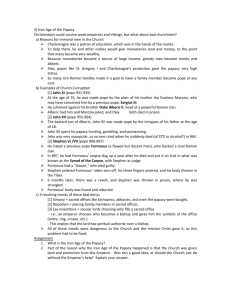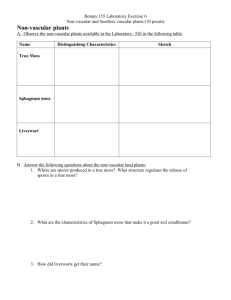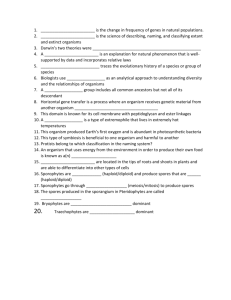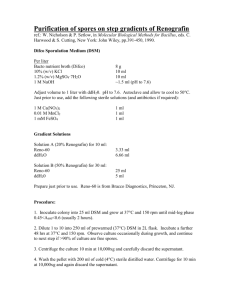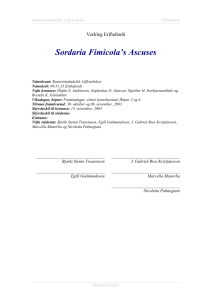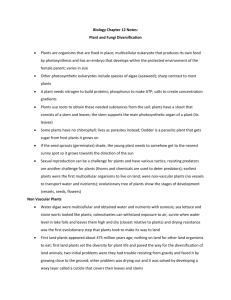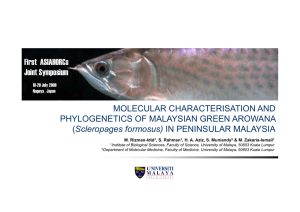Wieschollek-etal-2011-Roseodiscus-Text-engl-0001
advertisement
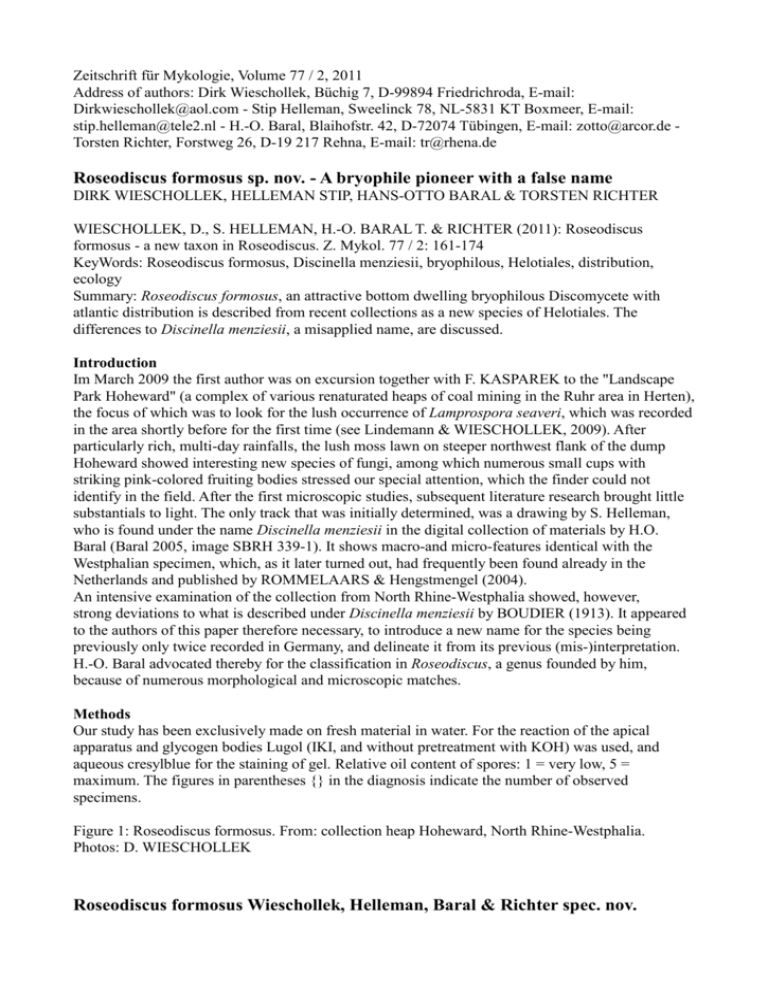
Zeitschrift für Mykologie, Volume 77 / 2, 2011
Address of authors: Dirk Wieschollek, Büchig 7, D-99894 Friedrichroda, E-mail:
Dirkwieschollek@aol.com - Stip Helleman, Sweelinck 78, NL-5831 KT Boxmeer, E-mail:
stip.helleman@tele2.nl - H.-O. Baral, Blaihofstr. 42, D-72074 Tübingen, E-mail: zotto@arcor.de Torsten Richter, Forstweg 26, D-19 217 Rehna, E-mail: tr@rhena.de
Roseodiscus formosus sp. nov. - A bryophile pioneer with a false name
DIRK WIESCHOLLEK, HELLEMAN STIP, HANS-OTTO BARAL & TORSTEN RICHTER
WIESCHOLLEK, D., S. HELLEMAN, H.-O. BARAL T. & RICHTER (2011): Roseodiscus
formosus - a new taxon in Roseodiscus. Z. Mykol. 77 / 2: 161-174
KeyWords: Roseodiscus formosus, Discinella menziesii, bryophilous, Helotiales, distribution,
ecology
Summary: Roseodiscus formosus, an attractive bottom dwelling bryophilous Discomycete with
atlantic distribution is described from recent collections as a new species of Helotiales. The
differences to Discinella menziesii, a misapplied name, are discussed.
Introduction
Im March 2009 the first author was on excursion together with F. KASPAREK to the "Landscape
Park Hoheward" (a complex of various renaturated heaps of coal mining in the Ruhr area in Herten),
the focus of which was to look for the lush occurrence of Lamprospora seaveri, which was recorded
in the area shortly before for the first time (see Lindemann & WIESCHOLLEK, 2009). After
particularly rich, multi-day rainfalls, the lush moss lawn on steeper northwest flank of the dump
Hoheward showed interesting new species of fungi, among which numerous small cups with
striking pink-colored fruiting bodies stressed our special attention, which the finder could not
identify in the field. After the first microscopic studies, subsequent literature research brought little
substantials to light. The only track that was initially determined, was a drawing by S. Helleman,
who is found under the name Discinella menziesii in the digital collection of materials by H.O.
Baral (Baral 2005, image SBRH 339-1). It shows macro-and micro-features identical with the
Westphalian specimen, which, as it later turned out, had frequently been found already in the
Netherlands and published by ROMMELAARS & Hengstmengel (2004).
An intensive examination of the collection from North Rhine-Westphalia showed, however,
strong deviations to what is described under Discinella menziesii by BOUDIER (1913). It appeared
to the authors of this paper therefore necessary, to introduce a new name for the species being
previously only twice recorded in Germany, and delineate it from its previous (mis-)interpretation.
H.-O. Baral advocated thereby for the classification in Roseodiscus, a genus founded by him,
because of numerous morphological and microscopic matches.
Methods
Our study has been exclusively made on fresh material in water. For the reaction of the apical
apparatus and glycogen bodies Lugol (IKI, and without pretreatment with KOH) was used, and
aqueous cresylblue for the staining of gel. Relative oil content of spores: 1 = very low, 5 =
maximum. The figures in parentheses {} in the diagnosis indicate the number of observed
specimens.
Figure 1: Roseodiscus formosus. From: collection heap Hoheward, North Rhine-Westphalia.
Photos: D. WIESCHOLLEK
Roseodiscus formosus Wieschollek, Helleman, Baral & Richter spec. nov.
Holotype: The Netherlands, North Brabant, 37 km south of Arnhem, 1 km north of Boxmeer,
Maasheggen, about 12 m above sea level, nursery on fluvial gley, N-exposed side of moist furrow,
relatively bare ground between and often on dead, algae-covered Ceratodon purpureus with some
Bryum argenteum; 23.II.2004, leg S. Helleman, herbarium Helleman (SBRH 339).
a
Etymol. From Latin formosus: shapely, beautiful.
Apothecia (1) 1,5-4 (5) mm in diameter, singly to gregarious, sometimes with branched stem,
turbinate to stalk-plate-shaped; Disc flat to convex, pale to bright flesh- or salmon-pink, almost
pink, stem (1) 2-4 (6) mm long, fleshy, thick, cylindrical to obconical, pale milky white, translucent
towards the base, flesh pink toward the edges. Asci: *(89) 100-133 (140) × 9-11 (12) µm {6}, dead
in water or KOH (63) 70-95 (106) × (6.5) 7-8 (9) {4} µm, fusoid-clavate (in the upper part
cylindrical or towards apex gradually tapered), 8-spored, spores in living asci obliquely biseriate, in
dead asci ± obliquely uniseriate, upper spores usually inversely oriented {2}, pars sporifera *35-40
µm long, apex significantly tapered, apical ring in Lugol moderately to strongly (orange-) red {7,
type RR}, negative in Melzer (without KOH), KOH-pretreated strongly blue in Lugol or Melzer,
1.5-2 (3.8) × 1.6–1.8 µm {1}, of Calycina-type, with croziers {7}. Ascospores: * (9,5-11) 12-18
(20-23) x (3) 3,5-4,2 (4,5-5) µm {7}, mean 13-16 × 3.7–4 µm, L: W = (2.8) 3.2 to 4.5 (5), in KOH
9-14 (16) × 3–3.5 (3.7) µm, ellipsoid-fusoid or often significantly clavate, hyaline, smooth, with
delicate, mucous envelope (in aqueous cresylblue staining bright purple), with several small lipoid
drops in each spore half {7}, oil content (1)2-3, with a central nucleus, two glycogen bodies
detectable reacting red in Lugol {4}, overripe or germinating spores, 1(2)× septate (exceptionally a
spore septate in the living ascus). Paraphyses: terminal cell * (15) 20-30 (35) × 2 to 3.5 µm, lower
cells * 15-22 (30) × 2 –2.5 µm, apically not or only slightly swollen (often slightly lageniform),
often ± curved (curved walking-stick- like), branched particularly in the upper half, hyaline, in
living state with no apparent content. Ectal Excipulum: hyaline, on the flanks 70 µm thick, textura
prismatica, cells thin-walled, hyaline, *(15) 20-30 (37) × 70-10 µm, in stem of highly elongated
cells (t-prismatica-porrecta). cells *(17) 25-60 (83) × 5-10 (15) µm, towards margin 20-30 µm
thick; flanks and margo with hyphoid, * 2-5 µm wide, appressed outgrowths, stipe with very few
hyphoid short, 2-3.5 µm wide hairs. Medulla: hyaline, of irregularly oriented, densely packed,
broad hyphae (t. intricata, cell *(20) 30-50 (75) × (6) 8-12 (15) µm{2}), not gelatinized, in stipe of
parallel upwards emerging t. porrecta (* cells (20) 30-50 (70) × 7-12 (14) µm {2}. Subhymenium
hyaline, 50 µm thick, made of thin, irregularly oriented, relative densely packed hyphae (t. intricata).
Drought tolerance: after 1 day or 2 weeks many spores still living, other elements dead
Figure 2: Roseodiscus formosus, collection Maasheggen (Holotype, S.B.R.H. 339). a: fresh
apothecia b: ascospores (living state, with central nucleus, right in IKI, with glycogen bodies) c:
Apex of living mature ascus, Paraphyses; d: Apex of dead immature ascus, in IKI; e: Ascus bases
arising from croziers, f: cortical cells of the ekcal excipulum in the stem, with hair outgrowth. –
Drawing: S. Helleman
Habitat: At low altitude (0-80 m asl.) on sandy, acid ± soil, closely associated with various,
mostly acrocarpous mosses: particularly Ceratodon purpureus {8}, also Cephaloziella
divaricata {2}, Campylopus introflexus (1), Bryum argenteum (1) and Bryum sp. {1},
Polytrichum (juniperinum) {1}, associated with various unicellular and filamentous
algae, lichens, and mushrooms.
Further specimens examined: Germany, North Rhine-Westphalia, 7.8 km NE of Gelsenkirchen,
3.7 km SE of Herten (see above), MTB 4409 / 1, Halde Hoheward, about 80 m above sea level, SWexposed slope with dense moss lawn, between various algae-covered mosses as Campylopus
introflexus, Cephaloziella divaricata, particularly Ceratodon purpureus, on dead areas, in the same
region also Bryoscyphus dicrani, 14.III.2009, leg F. Kasparek / D. Wieschollek, det. H.-O. Baral / D.
Wieschollek; Wieschollek herbarium. - Hamburg, 13.5 km ESE of Hamburg, 0.4 km S of Boberg,
MTB 2426 / 4, NSG Boberger lowland, environment of an inland dune 10 m above sea level, on
sand between Cephaloziella divaricata, Bryum sp., away Ceratodon purpureus also, 12.II.2011, leg
M. VEGA (2 fruitbodies); det. T. Richter. Netherlands, North-Holland, 5 km NNW of Hilversum,
1.5 kmWSW of Bussum, Cruysbergen, 0 m above sea level, on former agricultural soil, where the
fertile surface was removed, between Ceratodon purpureus, 22.I.2008, leg G.J. Kroon, herbarium
Helleman (S.B.R.H. 465). - Gelderland, 9 km E of Zutphen, 5 kmWSW of Lochem, Kienveen, 15
m above sea level, on Ceratodon purpureus, ancient pasture, where the topsoil has been removed
three years ago, 19.II.2011, leg M. Gotink, herbarium Helleman (S.B.R.H. 686). - Overijssel, 15 km
south of Hoogeveen, S outskirts of Dedemsvaart, at the pond edge (Kotermeer), 7 m above sea
level, on Ceratodon purpureus, leg Erik W. Heim, 25.II.2011, herbarium Helleman (S.B.R.H. 688).
- Noord-Brabant, 5 km SW of Tilburg, Kaaistoep, sandy shore where a pond was dug ("Prikven"),
on Ceratodon purpureus, leg. L. Rommelaars, 19.II.2011, herbarium Helleman (SBRH 689). - 2 km
SW of Boxmeer, Kleine Broekstraat, 13 m above sea level, nursery, between Ceratodon purpureus
(partly), with Polytrichum juniperinum; 7.III.2011, leg S. Hellemann, herbarium Helleman
(S.B.R.H. 690, H.B. 9472).
Not examined specimens (seen by us only on the basis of macrophotos): Netherlands, Overijsel,
6.5 km NNW of Oldenzaal, 2.6 km NE of Weerslo, meden Rossum, 21 m above sea level, between
Ceratodon purpureus, with Omphalina chlorocyanea, 9 & 15.III.2011, leg G. Winkel. - Overijsel,
5.8 km ESE of Oldenzaal, 2.7 km SSE of Lutte, Duivelshof, 36 m above sea level, between
Ceratodon purpureus, 18.III.2008, leg G. Winkel. - North-Holland, 0.5 km northwest of Bergen,
Bergerbos, 19.I.2011, leg. L. Knijnsberg. - Zeeland, 14 km NNW of Sint-Niklaas, 1 km SE of
Hulst, (Waterstraat) between Ceratodon purpureus, with Omphalina spec. 22.IV.2007, leg. L.
Noens. 164
The genus Roseodiscus
The genus was Roseodiscus drawn up in Baral & Krieglstein (2006) with three species,
which were previously incorporated into Hymenoscyphus, but differ by a strongly deviating type of
apical ring (thick-walled, reaching up to the ascus tip, apically considerably widened). As a further
distinguishing feature, the color of apothecial disc needs emphasis, showing fresh always a pinkpurple tone. Molecular biological studies (Zhang & ZHUANG 2004) have shown that the type
species R. rhodoleucus is closer to Calycina, with which it also shares the apical ring type. Two of
the three Roseodiscus species grow on dead stems of Equisetum. The third, R. subcarneus (Sacc.)
Baral, grows parasitically on various mosses.
Figure 3: Roseodiscus formosus, Collection Boberger lowland, Hamburg. A: habit, fresh apothecia
between Bryum and Cephaloziella divaricata, B: Ascospores with lipid droplets (viable),
B1: ascospores in IKI, with glycogen bodies, B2: germinating ascospores C: mature asci (viable),
C1: ascus apex with apical ring (dead, in ICI), D: paraphyses (living state). Drawing: T. Richter.
Figure 4: Roseodiscus formosus. Collections from the Netherlands. a-d: fresh apothecia between
Ceratodon purpureus, e: Median section through apothecium; f-g: median section through margo
and stem; h-i: mature asci, paraphyses; j-l: Ascus apex blue in Lugol (red after KOH treatment), mp: ascospores (in Lugol o: with glycogen bodies). - Living state, with the exception of j-l. —
b-d, l, p: Collection Cruysbergen, North-Holland (Photo: S. Helleman, SBRH 465), n: Collection
Kaaistoep (Photo: S. Helleman, SBRH 689), o: Collection Kienveen (Photo: S. Helleman, SBRH
686), a, f-i, k, m: Collection Kleine Broekstraat, North Brabant (photos: HO Baral, HB 9472).
Due to the binding to moss, R. formosus should be very close to R. subcarneus. The latter
species differs by slender, never turbinate apothecia with rather thin stems, euamyloid (IKI blue)
apical rings, and much smaller asci (most *52-66 × 6.5-7.5 µm) and spores (about 5-10 × 2-3 µm).
In contrast to R. formosus, the paraphyses contain in the upper part weakly refractive guttules
(vacuolar bodies).
Discussion
Confusion with Discinella menziesii (Boud.) Boud. ex A.L. Sm & Ramsb.
The unequivocal and mostly Netherlands collections of Roseodiscus formosus
(there called Roze Grondschijfje = "Pink soil slice") was obtained from various
Dutch websites (see http://waarneming.nl/soort/view/13508) as previously
misinterpreted as Discinella menziesii (Boud.) Boud. ex A.L. Sm & Ramsb. (1914). This
misdiagnosis should go back to the article of ROMMELAARS & Hengstmengel (2004), who
presented for the first time in detail the here discussed species under the name D. menziesii. It
appears puzzling, why the authores did not achieve to the original diagnosis of BOUDIER (1913).
A confrontation with Boudier's species concept of D. menziesii, yes even a cursory
look at the published figure reveals strong differences to the characteristics
of the collections regarded here, which are micro- and macroscopically almost identical
and well correspond to the diagnosis in ROMMELAARS & Hengstmengel.
Fig 5: Discinella menziesii. Original image of the first description by BOUDIER (1913, Pl 2, Fig II,
as Calycella Menziesi).
This starts with the size of the apothecia, which BOUDIER and in succession
DENNIS (1956: 116), Ellis & Ellis (1998: 68) and Anderson (2001) give to just over one
centimeter in diameter (rarely to 17 mm) and which usually start only from 5 mm upwards (in
ANDERSON, however, from 2 mm). The apothecia of R. formosus are, however,
on average approximately 2-3 mm in diameter (in ROMMELAARS & Hengstmengel
max. 7 mm). The cup- or dish-shaped, always short-stemmed habit of the
Figure 6: Discinella menziesii. La Palma, Los Tilos, 5.XII.2010, leg B. FELLMANN, HB 9460. a,
c: fresh apothecia b: ditto, median section; d: median section through margo; e: ditto (edge) f: inner
ectal excipulum of t. prismatica; g: external ectal excipulum of t. porrecta embedded in gel; h: fully
turgescent asci; i-j: ascus tips dead in IKI, without (apical ring red) and (blue apical ring) with KOH
pretreatment, k: ditto (living state in IKI), l: ascospores. Photos: H.-O. Baral, c & d: B.
FELLMANN
apothecia of BOUDIER's taxon does not fit with the collections together such as
they are documented by Dutch authors or on various internet sites, which
show all fleshy turbinate fruit bodies with disk- to cushion-shaped (flat to
convex) hymenia, some of which are quite long-stalked, or show a Cudoniella
Ombrophila- habit, while typical Discinella species such as D. menziesii and D. boudierii
(Quél.) Boud. are purely morphological comparable rather to operculate genera such as
Leucoscypha, Tricharina or (after BOUDIER) Geopyxis (see also the color plate of D.
boudierii in Baral & Krieglsteiner 1985: 112).
Indeed, the shape of the shape of paraphyses and size of spores are nearly identical, but the guttular
relations in the spores are very different. Instead of the spores with two or three large guttules as
shown by BOUDIER, surrounded by numerous smaller (Fig. 5 & 6l, oil content 5), in our
collections occur exclusively spores with clusters of a few smaller guttules near the poles (Fig. 2bc, 3b, 4m-p, oil content 1-3). BOUDIER possibly examined the Scottish collection in the fresh state,
at least the drawn spores look as being alive.
In addition to the spore content, differences are observed in the spore shape: In Discinella
species, the spores are almost completely homopolar, so in free spores you
cannot distinguish between upper and lower end. In contrast, R. formosus
one can often speak of slightly to moderately club-shaped spores. These are not now,
as one would expect, all oriented with the wider end facing upwards within the ascus. R. formosus
shows here a very rare character in the Helotiales: the upper ~ 4 spores often show
their wider end pointing downwards, but often only the only slight polarity of the
spores is not particularly noticeable (unclear to recognize in Figs 3c and 4i). Although the asci
are certainly able to shoot, the ejection of spores could not be observed in the water mounts. While
the spores in our observations were mostly non-septate or sometimes with
a septum (the latter often only during germination), ROMMELAAR &
Hengstmengel have also documented 2-3-septate spores. The spores of real Discinella species,
however, do not appear to germinate or to develop a septum in old apothecia.
One major difference is the design of the shape of the margin (Fig. 4f and
6c): Discinella species have a medium brown ectal excipulum, which is strongly widened at the
outermost edge and significantly protrudes above the hymenium, while the entirely hyaline ectal
excipulum in R. formosus is thin at the margin and not protruding. Moreover, in Discinella species a
mighty layer of thin gelatinized hyphae covers the actual ectal excipulum of t. prismatica (Fig. 6e,
g). This layer is entirely absent in R. formosus (Fig. 4f-g).
The red iodine reaction in Lugol (hemiamyloid) and the shape of the apical ring in our fungus,
however, resembles typical Discinella species. BOUDIER, ANDERSON and ELLIS & ELLIS did
not specify this feature, while DENNIS reported a blue reaction in Melzer's reagent, apparently
because he pretreated with KOH.
Also ROMMELAARS & Hengstmengel (lc) give a clear blue reaction in Melzer's
Reagent. This was only to obtain after KOH treatment (L. ROMMELAARS,
personal communication). The absence of a reaction without KOH is an unequivocal proof that
these collections would react red in Lugol.
The well-documented report by ANDERSON (2001) under the name D. menziesii refers
on an Irish find with fusoid spores with large guttules and expanded, irregularly lobed, pink
apothecia, which to the best fit Boudier's protolog. Similar well fits the here illustrated find from La
Palma (Fig. 6). Discinella menziesii is a critical taxon, which, with its slightly larger spores
does not very sharply differ from the type species D. boudierii. Besides, a possible
synonymy of D. menziesii with the Macaronesian Geocoryne variispora
Korf remains to be clarified.
Other possibilities of confusion
Roseodiscus formosus is fairly well characterized already in the field by its bright pink to salmon
pink color and its location among moss, in comparison to similar soil inhabitants of the Helotiales.
Representatives of the bryophile genus Bryoscyphus, which is related to Hymenoscyphus, are
usually white- colored, much smaller, and show a blue iodine reaction (in the typical case of the
Hymenoscyphus-type) or even no reaction at all. Species of the genus Ombrophila (e.g.
O. violacea (Alb. and Schwein.) Fr. or O. limosella (P. Karst.) Rehm) can macroscopically
be similar, but differ microscopically by more homopolar, fusoid spores, IKI-blue (euamyloide)
apical rings of the Hymenoscyphus- type, and a more or less pronounced gelatinisation of the
medullary excipulum (relatively narrow hyphae with abundant intercellular space). Roseodiscus
subcarneus also differs by an IKI-blue reaction of the ascus pore (without KOH pretreatment).
Because of its pink bryophilous apothecia, S. HUHTINEN pointed our attention to the
original description of Helotium polytricola P. & H. Crouan. The original watercolor that was
available as a scan thanks to J.-P. PRIOU, however, shows that quite similar short-stalked apothecia
sit at the top region of green leaves of Polytrichum commune, and the living spores contain two
relatively large guttules (Fig. 7). This never found again discomycete could be sought, according to
the host moss, in more acidic and more permanently wet habitats, e.g. in the bog.
Figure 7: Helotium polytricola on Polytrichum commune. Type illustration of H. & P.
Crouan. Courtesy of Curator of the Museum of Concarneau (Dept. Finistère).
Distribution
It is difficult to make accurate statements about the distribution of Roseodiscus formosus in
Germany, since the species was perhaps already in early times mixed with Discinella menziesii. In
the German distribution atlas (Krieglsteiner 1993: 507) is a single entry under the name
D. menziesii for a finding in Schleswig-Holstein at the border of Hamburg. On request, the finder P.
STEINDL made us his documentation available. The collection identified as "D. cf menziesii"
turned out to be Ombrophila limosella (sessile, more violet apothecia, between Marchantia
polymorpha, spores fusoid, with a few tiny guttules). Also in the preliminary ascomycete flora
(Baral & Krieglsteiner 1985: 114) the mentioned collections of D. cf. menziesii turned out in
retrospect to be Ombrophila limosella (Baral, ined.). Otherwise, only in the fungal flora of Bayreuth
(Beyer 1992: 61) a documented record of D. menziesii is found (unillustrated) which, however, due
to the macroscopic data (apothecia black, white subsessil, 2-6 mm diam.), does not match the
present collections [of R. formosus], and because of the tiny guttules in the spores it cannot belong
to the real D. menziesii, also the ecological information "on bare earth" is not in concordance with
Roseodiscus formosus. Our here documented collections from North Rhine-Westphalia and
Hamburg are the only so far known records of R. formosus in Germany.
In the Netherlands the "roze grondschijfje" (Discinella menziesii s. auct.) is regularly found in both
coastal and inland since several years, and is numerously documented there (see
http://waarneming.nl/soort/view/13508). A first mention of Roseodiscus formosus is found in E.
ARNOLD et al. (1995), who indicates a collection
Figure 8: Current known distribution of Roseodiscus formosus. 1 Hulst, 2 Kaaistoep, De Leij, 3 & 4
Boxmeer, 5 Bussum, 6 Bergen, 7 Kotermeer, 8 Kienveen, 9 Rossumer meden, 10 Duivelshof, 11
Hoheward, 12 Boberg.
of 1958 near Apeldoorn (unfortunately without a name, exact date and ecology), which is apparently
identical with our species (Hengstmengel J., personal communication to S. Helleman, voucher in
Nationalherbarium Leiden). ROMMELAARS & Hengstmengel (2004) have demonstrated R.
formosus in the period of 2000 to 2011 many times, especially for the sites Kaaistoep and De Leij.
That the species could hardly be found so far in Germany sounds odd, as this is pretty member of
the Helotiales is very strikingly coloured and there should not be any lack of at appropriate sites.
Perhaps it was overl0ooked because of its very early appearance. On the other hand, a clear
distribution area in the Netherlands can be seen, according to current knowledge. The species seems
to require a mild and humid winter climate and therefore shows an atlantic distribution. The
predominantly recorded host moss Ceratodon purpureus, however, is a cosmopolitan with a dense
distribution within Central Europe from lowlands to high mountains. The occurrence of R. formosus
is thus not only explained with the presence of the host moss.
Figure 9: Roseodiscus formosus. a: collection Kienveen, Gelderland (Photo: S. Helleman, SBRH
686); b: Lowland collection Boberg, Hamburg (photo: T. Richter) C: collection Rossumer meden,
Overijsel (Photo: G. Winkel) d: Duivelshof site, Overijsel (Photo: G. Winkel). - The red stems on
a and b are young setae of Ceratodon purpureus.
Ecology
Roseodiscus formosus is a soil-inhabiting representative of the Helotiales, which mainly preferably
inhabits anthropogenic, barren and sandy, especially acidophilic pioneer locations such as coastal
dunes, heaths, abandoned fields or dumps with moss vegetation, thereby, however, needs strong and
long-lasting moisture. It is found mostly in old, often already dead moss cushions. Whether the
species has a parasitic bond to the substrate, could not yet sufficiently be clarified. Striking,
however, is the predominant presence of the leavy moss Ceratodon purpureus from the order
Dicranales (see above under Habitat), whose leaflets show partly a bleaching near the apothecia
(see Fig. 1a-b, 4a-b).
In the similar R. subcarneus the bleaching of the moss is explained by a parasitic relationship. The
apothecial stalks rise here always directly from the moss stem, but this also was partially the case
with R. formosus. Also ROMMELAARS & Hengstmengel (l.c.) feature an apothecium that emerges
from the base of Ceratodon purpureus.
The collections made so far come almost exclusively from the months of January to April, with an
emphasis in February-March. Considering the many sun-exposed habitats, occurrence in the
summer months is hardly to be expected.
The apparent increase in populations in the Netherlands over the past decades
could be related with local restoration measures, which intends to lead back former
agriculture and pasture land to natural areas. Thereby, the artificially fertilized surface layers are
removed. After about three years, a pioneer moss vegetation has settled which provides the
conditions for the occcurrence of R. formosus.
Thanks
For the provision of literature, imagery and field information, we sincerely thank
M. Bemmann, B. Fellmann, S. Huhtinen, F. Kasparek, U. Lindemann, M. Parslow, J. P. Priou,
P. Steindl, M. Vega and G. Winkel.

